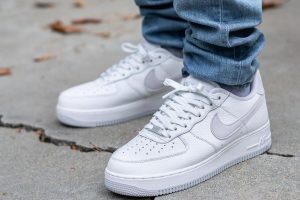The Nike Dunk versus Air Force 1 fit comparison is a common question, and at COMPARE.EDU.VN, we’re here to provide clarity on their sizing differences to help you make the right choice when purchasing either iconic sneaker. Understanding the nuances of each model ensures a comfortable and stylish fit. Explore the details of sneaker sizing, fit comparison, and footwear selection at COMPARE.EDU.VN.
1. Understanding the Fundamental Fit Differences
The Air Force 1 and Nike Dunk are two of the most iconic sneakers in the world. While both are Nike classics, they offer distinct fits. Understanding these differences is crucial for ensuring a comfortable and stylish experience. The key distinction lies in their overall volume and structure.
- Nike Dunk: Generally fits true to size, offering a more streamlined and snug feel.
- Air Force 1: Known for its roomier fit, often described as fitting “big.”
These differences stem from the design and construction of each shoe. The Air Force 1, originally designed as a basketball shoe, prioritizes cushioning and support, leading to a bulkier build. The Dunk, initially intended for the basketball court as well but later adopted by skateboarders and streetwear enthusiasts, has a more streamlined silhouette.
2. Sizing Recommendations: Nike Dunk
The Nike Dunk typically adheres to standard sizing guidelines. This means that most people will find their usual shoe size to be the most appropriate fit. However, individual foot shapes and preferences can influence the ideal size.
- Standard Foot: True to size is generally recommended.
- Narrow Foot: Some individuals with narrower feet may consider going down half a size for a snugger fit, especially in newer releases with thinner materials.
- Wide Foot: Those with wider feet may find true to size to be comfortable, as the Dunk’s toebox offers reasonable room.
It’s important to note that older Dunk models, particularly those from the late 90s to mid-2000s, often feature more pliable materials and a slightly roomier fit. If you’re purchasing a vintage pair, this is something to consider.
3. Sizing Recommendations: Air Force 1
The Air Force 1’s fit is where many people encounter sizing questions. Due to its generous volume, the AF1 often feels larger than other Nike models.
- General Recommendation: Most people find that going down half a size from their usual shoe size provides the best fit.
- True to Size: If you prefer a roomier fit or plan to wear thick socks, sticking with your true size might be preferable.
- Narrow Foot: Individuals with narrow feet may need to go down a full size for a more secure feel.
The Air Force 1’s larger fit is particularly noticeable in the toebox, which offers ample wiggle room. This can be beneficial for those with wider feet or those who appreciate a less constricting feel.
4. Detailed Comparison Table: Nike Dunk vs. Air Force 1 Sizing
To illustrate the sizing differences, here’s a comparison table:
| Feature | Nike Dunk | Air Force 1 |
|---|---|---|
| General Fit | True to Size | Runs Large |
| Recommendation | Usual Shoe Size | Half Size Down |
| Toebox | Moderate Room | More Room |
| Material Impact | Stiffer materials can feel snugger | Less Impact on Sizing |
| Older Models | May fit slightly roomier | Consistent Fit Across Models |



5. Factors Influencing Fit: Materials and Construction
The materials used in both the Nike Dunk and Air Force 1 play a significant role in how the shoes fit and feel.
- Nike Dunk: Newer Dunk releases often utilize less premium materials, which can contribute to a slightly looser feel compared to older models with thicker, more durable leathers.
- Air Force 1: The AF1’s robust construction and use of thicker materials contribute to its overall bulkier fit. The padding around the ankle collar and tongue further enhances this feeling.
These material differences also affect the shoe’s break-in period. Dunks generally require a shorter break-in period, while Air Force 1s may take longer to soften and mold to the wearer’s foot.
6. Highs vs. Lows: Does Cut Affect Fit?
An important consideration is whether the high or low cut of each shoe affects its fit. Generally, the cut has minimal impact on the overall length and width of the shoe.
- Nike Dunk High vs. Low: Both versions typically fit true to size, with the primary difference being ankle support.
- Air Force 1 High vs. Low: Similar to the Dunk, the high and low versions maintain a consistent fit, with the high-top offering more ankle coverage.
However, personal preferences may vary. Some individuals find that high-tops offer a more secure feel, while others prefer the freedom of movement provided by low-tops.
7. The Impact on Height: Midsole Differences
Another factor to consider is the midsole height of each shoe. The Air Force 1 is known for its significantly taller midsole compared to the Dunk.
- Nike Dunk: Offers a modest height boost of approximately 3cm in the heel and 2cm in the toe.
- Air Force 1: Provides a more substantial height increase of around 4cm in the heel and 3cm in the toe.
If you’re looking for a sneaker that adds noticeable height, the Air Force 1 is the clear winner. However, the Dunk’s lower profile may be preferable for those who prefer a more understated look.
8. Styling Considerations: Proportions and Aesthetics
The fit and silhouette of each shoe also influence how they pair with different outfits.
- Nike Dunk: Its streamlined design makes it a versatile choice that complements both skinny and baggy jeans. The Dunk’s proportionate appearance prevents it from looking overly bulky.
- Air Force 1: The AF1’s larger profile can sometimes appear disproportionate with narrower pants. It tends to work best with more relaxed or streetwear-inspired outfits.
Ultimately, the choice between the Dunk and Air Force 1 depends on personal style preferences. Both are classic sneakers that can elevate any wardrobe, but their distinct aesthetics cater to different tastes.
9. Nike SB Dunk: A Different Sizing Landscape
It’s crucial to distinguish between regular Nike Dunks and Nike SB Dunks, as the latter often presents a different sizing experience.
- Nike SB Dunk: Modern SB Dunks tend to fit more snugly due to extra padding and a more performance-oriented design. Many people find that they need to size up half a size in SB Dunks.
- Older SB Dunks: Similar to regular Dunks, older SB Dunk models often feature more accommodating materials and a slightly roomier fit.
If you’re considering purchasing a pair of SB Dunks, it’s advisable to research specific models and read reviews to get a better understanding of their individual fit characteristics.
10. Nike Official Size Chart: A General Guideline
While the recommendations above offer a helpful starting point, it’s always a good idea to consult Nike’s official size chart. This chart provides measurements for various shoe sizes and can help you determine the most appropriate size based on your foot length. You can find Nike’s official size chart on their website.
11. Trying On In-Store: The Ideal Scenario
Whenever possible, the best way to ensure a proper fit is to try on both the Nike Dunk and Air Force 1 in a physical store. This allows you to directly compare the feel of each shoe and determine which size provides the most comfortable and secure fit for your foot.
12. Understanding Foot Shape: A Personalized Approach
It’s crucial to remember that everyone’s feet are unique. Factors like arch height, width, and toe shape can all influence how a shoe fits. Taking these individual characteristics into account can help you make a more informed sizing decision.
13. Sock Thickness: A Subtle Adjustment
The thickness of the socks you plan to wear with your sneakers can also affect the fit. If you typically wear thick socks, you may want to consider sizing up half a size, especially in the Air Force 1. Conversely, if you prefer thin socks, you may be able to stick with your true size or even size down.
14. Online Reviews: Gathering Insights from Others
Before making an online purchase, it’s always wise to read reviews from other customers who have purchased the same shoe. These reviews can provide valuable insights into the shoe’s sizing and fit characteristics. Look for reviews from people with similar foot shapes to your own for the most relevant information.
15. Return Policies: A Safety Net
When purchasing sneakers online, it’s essential to check the retailer’s return policy. A generous return policy allows you to try on the shoes at home and return them if they don’t fit properly. This provides peace of mind and ensures that you’re not stuck with a pair of shoes that are uncomfortable or the wrong size.
16. Nike Dunk vs. Air Force 1: A Summary of Key Differences
To recap, here are the key differences between the Nike Dunk and Air Force 1:
- Fit: Dunk fits true to size; Air Force 1 runs large.
- Sizing Recommendation: Dunk – usual shoe size; Air Force 1 – half size down.
- Midsole Height: Dunk – modest height boost; Air Force 1 – more substantial height increase.
- Aesthetics: Dunk – streamlined and versatile; Air Force 1 – bolder and more voluminous.
17. Comfort and Performance: Beyond Sizing
While sizing is crucial, comfort and performance are equally important considerations. Both the Nike Dunk and Air Force 1 offer unique comfort experiences.
- Nike Dunk: Provides a more responsive and connected feel, making it a popular choice for skateboarding and other activities that require agility.
- Air Force 1: Offers superior cushioning and support, making it ideal for all-day wear and activities that involve impact.
Ultimately, the best choice depends on your individual needs and preferences.
18. The Enduring Appeal of Both Sneakers
Despite their sizing and fit differences, both the Nike Dunk and Air Force 1 have cemented their status as iconic sneakers. Their enduring appeal stems from their timeless designs, rich history, and cultural significance. Whether you prefer the Dunk’s streamlined versatility or the Air Force 1’s bold presence, both sneakers offer a unique and compelling style statement.
19. Making the Right Choice: A Personalized Decision
Choosing between the Nike Dunk and Air Force 1 is a personal decision that depends on your individual preferences, foot shape, and style. By understanding the nuances of each shoe’s fit and considering the factors outlined in this guide, you can make an informed choice that ensures a comfortable and stylish experience.
20. The Benefits of Informed Sneaker Shopping
In the world of sneaker collecting and fashion, making informed decisions is paramount. Understanding the nuances of sizing, fit, and style can prevent costly mistakes and ensure that you’re always putting your best foot forward. By taking the time to research and consider your individual needs, you can build a sneaker collection that reflects your personal taste and provides lasting comfort and satisfaction.
21. How to Care For Your Nike Dunks and Air Force 1s
Once you’ve found the perfect fit, it’s important to properly care for your Nike Dunks and Air Force 1s to extend their lifespan and maintain their appearance.
- Cleaning: Regularly clean your sneakers with a soft brush and mild soap to remove dirt and debris.
- Storage: Store your sneakers in a cool, dry place away from direct sunlight to prevent fading and damage.
- Protection: Consider using a sneaker protector spray to shield your shoes from water and stains.
With proper care, your Nike Dunks and Air Force 1s can remain stylish and comfortable for years to come.
22. Nike Adapt Technology: The Future of Fit?
Nike has been experimenting with innovative technologies to address the challenges of sizing and fit. One such technology is Nike Adapt, which uses power-lacing to automatically adjust the shoe to the wearer’s foot. While Adapt technology is not yet widely available on Dunks or Air Force 1s, it represents a potential future direction for sneaker sizing and customization.
23. The Psychology of Sneaker Fit
The way a sneaker fits can have a significant impact on your overall comfort and confidence. A well-fitting shoe can enhance your posture, reduce fatigue, and improve your overall sense of well-being. Conversely, a poorly fitting shoe can lead to discomfort, blisters, and even long-term foot problems.
24. The Evolution of Sneaker Sizing
Sneaker sizing has evolved over time, with variations between brands and even within the same brand. Understanding these historical trends can provide valuable context when making sizing decisions. For example, vintage sneakers often fit differently than modern releases due to changes in materials and manufacturing processes.
25. Nike By You: Customizing Your Fit
Nike By You allows you to customize various aspects of your sneakers, including the materials, colors, and even the fit. While the customization options may not directly address sizing concerns, they can allow you to create a shoe that better suits your individual preferences and needs.
26. The Influence of Collaborations on Sizing
Collaborations between Nike and other brands or designers can sometimes influence the sizing of sneakers. Limited-edition releases may feature unique materials or construction techniques that affect the fit. It’s always a good idea to research collaborations and read reviews before making a purchase.
27. The Importance of Arch Support
Arch support is a crucial factor in overall sneaker comfort. Individuals with high arches may require shoes with more pronounced arch support, while those with flat feet may prefer shoes with minimal arch support. Both the Nike Dunk and Air Force 1 offer moderate arch support, but aftermarket insoles can be used to customize the level of support to your individual needs.
28. Foot Conditions and Sneaker Fit
Certain foot conditions, such as bunions or hammertoes, can make it challenging to find sneakers that fit comfortably. Individuals with these conditions may need to seek out shoes with wider toeboxes or more accommodating materials. Consulting with a podiatrist can provide valuable guidance on selecting the right sneakers for your specific foot condition.
29. The Impact of Climate on Sneaker Fit
Climate can also influence how your sneakers fit. In hot weather, your feet may swell, requiring a slightly larger size. Conversely, in cold weather, your feet may shrink, allowing for a snugger fit. It’s important to consider these seasonal variations when making sizing decisions.
30. Sustainable Sneaker Sizing
As sustainability becomes increasingly important, some sneaker brands are exploring innovative approaches to sizing that reduce waste and minimize environmental impact. These approaches may include virtual try-on technologies, personalized sizing recommendations, and modular designs that allow for easy repair and replacement of individual components.
31. The Future of Sneaker Technology
The future of sneaker technology holds immense potential for improving sizing and fit. Advancements in 3D scanning, artificial intelligence, and personalized manufacturing could lead to sneakers that are custom-made to perfectly fit each individual’s foot. This would eliminate the guesswork and uncertainty that often accompany sneaker shopping.
32. Common Sizing Mistakes to Avoid
To avoid common sizing mistakes, be sure to:
- Measure your feet accurately using a Brannock device or ruler.
- Consult Nike’s official size chart.
- Read reviews from other customers.
- Consider your individual foot shape and preferences.
- Try on sneakers in-store whenever possible.
- Check the retailer’s return policy.
By following these guidelines, you can minimize the risk of purchasing sneakers that don’t fit properly.
33. Breaking In New Sneakers: A Gradual Process
Even if you’ve found the right size, new sneakers may require a break-in period to fully conform to your feet. Wear your new sneakers for short periods of time initially, gradually increasing the wear time as they become more comfortable. Using a shoe stretcher or wearing thick socks can also help to expedite the break-in process.
34. Alternative Lacing Techniques for a Better Fit
Experimenting with different lacing techniques can also improve the fit of your sneakers. For example, using a looser lacing pattern can provide more room in the toebox, while a tighter lacing pattern can offer more support and stability. Numerous online resources provide detailed instructions on various lacing techniques.
35. The Role of Insoles in Enhancing Comfort and Fit
Insoles can play a significant role in enhancing the comfort and fit of your sneakers. Aftermarket insoles can provide additional cushioning, arch support, and stability. They can also be used to address specific fit issues, such as heel slippage or excessive toe room.
36. Cleaning and Maintenance Tips
Regular cleaning and maintenance can help to extend the lifespan of your sneakers and maintain their appearance. Use a soft brush and mild soap to remove dirt and debris. Avoid using harsh chemicals or abrasive cleaners, as these can damage the materials. Allow your sneakers to air dry completely before storing them.
37. When to Replace Your Sneakers
Even with proper care, sneakers will eventually wear out and need to be replaced. Signs that it’s time to replace your sneakers include:
- Worn-down outsoles
- Loss of cushioning
- Tears or cracks in the upper
- Persistent odors
Replacing your sneakers regularly can help to prevent injuries and ensure that you’re always wearing shoes that provide adequate support and comfort.
38. Nike’s Commitment to Innovation
Nike is committed to continuous innovation in sneaker technology, design, and manufacturing. This commitment extends to improving sizing and fit, with ongoing research and development in areas such as 3D scanning, personalized manufacturing, and adaptive technologies.
In conclusion, understanding the fit differences between Nike Dunks and Air Force 1s is crucial for making informed purchasing decisions. At COMPARE.EDU.VN, we aim to provide you with the knowledge and resources you need to find the perfect sneakers for your individual needs and preferences.
For more detailed comparisons and expert advice, visit COMPARE.EDU.VN. Our team of experts is dedicated to providing you with the most comprehensive and objective information to help you make the best choices. Contact us at 333 Comparison Plaza, Choice City, CA 90210, United States, or via Whatsapp at +1 (626) 555-9090.
FAQ: Nike Dunk vs. Air Force 1 Sizing
-
Do Nike Dunks fit true to size?
Yes, Nike Dunks generally fit true to size for most people.
-
Do Air Force 1s run big?
Yes, Air Force 1s are known to run large, and it is often recommended to go down half a size.
-
Should I size up or down in Nike Dunks?
In most cases, you should stick with your true size for Nike Dunks.
-
What if I have wide feet?
If you have wide feet, sticking to your true size for Dunks is advisable, while considering going down only half a size for Air Force 1s.
-
Do Dunk Highs fit the same as Lows?
Yes, the fit is generally consistent between Dunk Highs and Lows.
-
Do older Dunk models fit differently?
Yes, older Dunk models may fit slightly roomier due to the use of more pliable materials.
-
How much height do Nike Dunks add?
Nike Dunks add approximately 3cm in the heel and 2cm in the toe.
-
Are SB Dunks sized differently?
Yes, modern SB Dunks tend to fit snugger, and sizing up half a size may be necessary.
-
Can I rely on Nike’s official size chart?
Yes, Nike’s official size chart can be a helpful starting point for determining your size.
-
Where can I find more comparisons?
For more in-depth comparisons, visit COMPARE.EDU.VN at 333 Comparison Plaza, Choice City, CA 90210, United States, or contact us via Whatsapp at +1 (626) 555-9090. At COMPARE.EDU.VN, we simplify your choices.
Now that you’re armed with all this knowledge, visit compare.edu.vn to explore more comparisons and make confident decisions.
